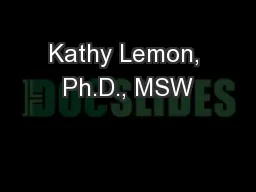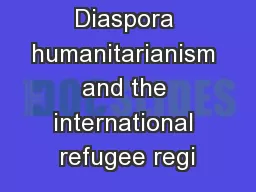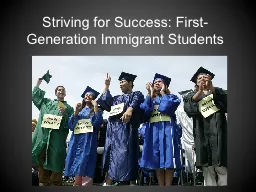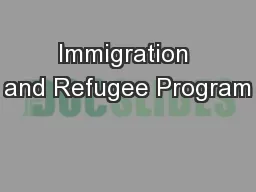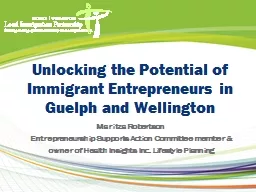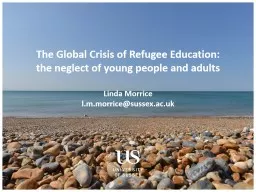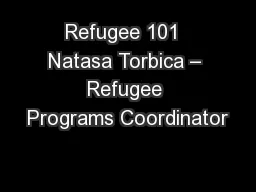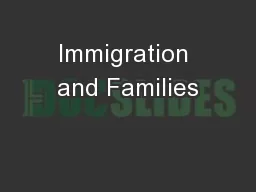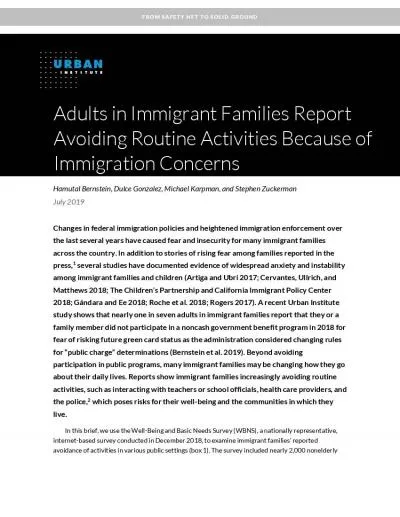PPT-1 Engaging Immigrant and Refugee Families in the Schools
Author : karlyn-bohler | Published Date : 2019-11-25
1 Engaging Immigrant and Refugee Families in the Schools Lyn Morland MSW MA Bank Street College of Education Agenda To relate the national PTA Standards for family
Presentation Embed Code
Download Presentation
Download Presentation The PPT/PDF document "1 Engaging Immigrant and Refugee Familie..." is the property of its rightful owner. Permission is granted to download and print the materials on this website for personal, non-commercial use only, and to display it on your personal computer provided you do not modify the materials and that you retain all copyright notices contained in the materials. By downloading content from our website, you accept the terms of this agreement.
1 Engaging Immigrant and Refugee Families in the Schools: Transcript
1 Engaging Immigrant and Refugee Families in the Schools Lyn Morland MSW MA Bank Street College of Education Agenda To relate the national PTA Standards for family school and community engagement to immigrants and refugees. CITIZENS. SURVEY. How immigrants . experience integration . in 15 European cities. PARTNERS. Belgium. . King . Baudouin. Foundation (KBF). Université. . Libre. de . Bruxelles. (ULB. ). France. Fondation. Centre . for. Social Justice and Change. MA . in . Refugee Studies. . 21. st. Century London Outcasts:. Austerity and its Impact on Refugee Families Living in London . The . symposium is organized in collaboration with:. Meekyung Han, Ph.D. MSW. School of Social Work . San Jose State University. Child Welfare Outcomes among Mexican and Vietnamese . Immigrant Children. Purpose of Today’s Webinar. To present key findings from a CalSWEC funded study, including:. Louise Olliff. PhD candidate. . (Anthropology & Development Studies), University of Melbourne. Senior Policy Officer, Refugee Council of Australia. Overview. Humanitarianism and the international refugee regime. What we know. Academic success of immigrant students in US schools will not only shape their own economic success but the entire US economy, along with its international competitiveness, welfare, health care, and retirement systems. What is Refuge Resettlement?. Founded in 1946. Mission: end hunger, promote peace and justice. Supported by 37 member communions . Program areas: food, water, assisting refugees and the vulnerable . Active in more than 30 countries. . Maritza Robertson. Entrepreneurship Supports Action Committee member & . owner of Health Insights Inc. Lifestyle Planning . What is the . Entrepreneurship Supports Action Committee?. Improve community supports . CHEER . 19 July 2017. Linda Morrice. l.m.morrice@sussex.ac.uk. A . world on the move …. At . the end of 2015 the forcibly displaced population reached a record high of 65.3 . million. . T. his . includes 21.3 million . . dcf.wisconsin.gov. A refugee is a person who is outside of his or her country and is unable or unwilling to return because of persecution or a well-founded fear of persecution. .. dcf.wisconsin.gov. Bukola. Salami. Assistant Professor. Faculty of Nursing. University of Alberta. Agenda. Immigrant Health and Healthy Immigrant Effect. Social Determinants of Health. Factors that Contribute to Immigrant Health. 23 million Southern and Eastern European immigrants in the years from 1880-1917... up to 70% of the population in America's largest cities... the two largest immigrant groups, Russian/Polish Jews and Italian Catholics... all these newcomers were viewed as inferior races in the genetic hierarchy of the day. Roona Ray, MD MPH. Physicians for a National Health Plan. Annual Conference. San Diego, 10 November 2018. Outline. & objectives// . Who are we?. Why is single payer a feminist, anti-racist, & pro-immigrant issue?. Law Enforcement and Prosecution Best Practices: Immigrant Crime Victims, Language Access and the U Visa Gulf Coast Center for Non- violence Conference Biloxi , Mississippi August 14, 2018 National Immigrant Women's Advocacy Project at the American University Washington College of Law Karpman and Stephen ZuckermanJuly 2019Changes in federal immigration policies and heightened immigration enforcement over the last several years have caused fear and insecurityfor many immigrant famil
Download Document
Here is the link to download the presentation.
"1 Engaging Immigrant and Refugee Families in the Schools"The content belongs to its owner. You may download and print it for personal use, without modification, and keep all copyright notices. By downloading, you agree to these terms.
Related Documents



